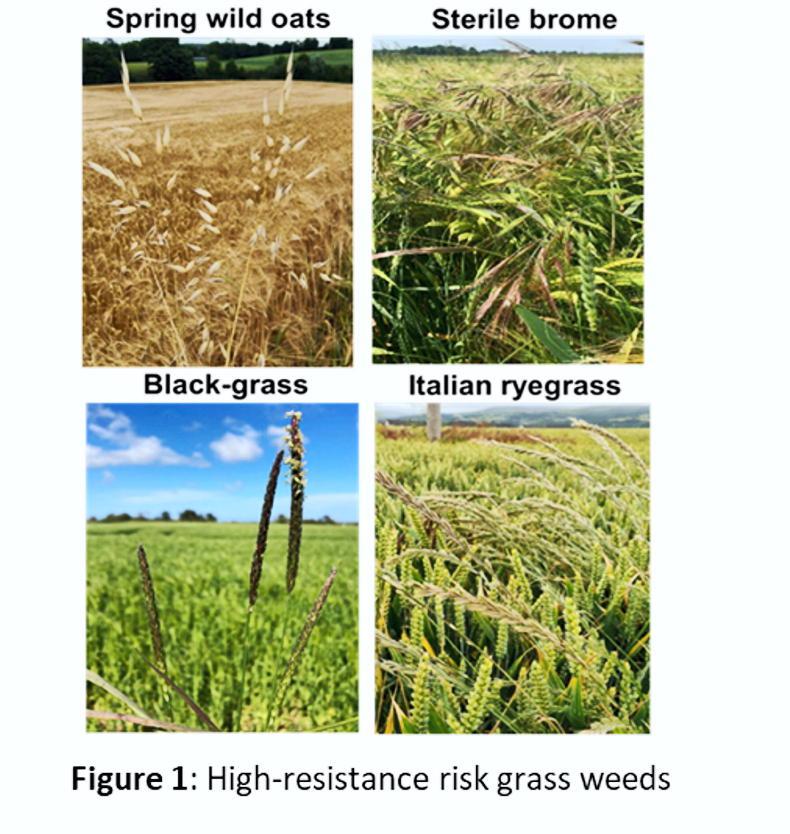Difficult-to-control grass weeds such as wild oats, sterile brome, blackgrass and Italian ryegrass (Figure 1) are increasing due to more winter cropping, earlier sowing, more non-inversion tillage, herbicide loss and resistance issues, and new weed introductions.

It is important that farmers keep on top of grass weed control. Visiting the grass weeds stand at the open day is a must to get to know your weeds.
Herbicide weed control based on repeated use of one product (particularly, from high-risk ACCase or ALS groups) risks resistance developing and shifting to resistant populations, resulting in the field population no longer being controlled by a particular herbicide group (Figure 2).

To date, we have located and tested resistant grass weeds to find:
19 out of 34 farms (56%) with black-grass were ACCase (eg Falcon and Stratos Ultra) and/or ALS (eg Pacifica)-resistant (Figure 3A). 12 out of 20 farms (60%) with Italian ryegrass were ACCase (eg Axial, Falcon or Stratos Ultra) and/or ALS (eg Pacifica, Broadway)-resistant (Figure 3B).28 out of 150 farms (19%) with wild oats were ACCase (eg Axial, Falcon or Stratos Ultra)-resistant only (Figure 3C). 
We have also found widespread tolerance in bromes to ALS-Pacifica and/or ACCase-Stratos Ultra; and a rare incidence of ALS-resistant annual meadowgrass, most likely as a consequence of using rates lower than the recommended rate.
As herbicide resistance limits growers’ weed management options, an integrated approach to weed control (IWM) that combines cultural/non-chemical tactics with targeted, judicious herbicide use is becoming important.
IWM methods include:
Crop walking, accurate identification and mapping of weeds.Crop rotation (eg cereal/non-cereal break crops; autumn/spring crops; grass/leys or fallows) and possibly cover crops.Stale seedbed technique and strategic tillage.Using certified seed and using seed rates higher than normal. Using competitive cultivars.Delayed drilling of winter cereals.Using less-risk, tank-mixed or stacked, pre-emergence residual herbicides in winter wheat and winter barley (eg Firebird + Defy or Firebird Met) or using non-ACCase and non-ALS herbicide, eg Kerb (propyzamide) in winter oilseed rape. Using robust rates and targeting optimum timing of spring herbicide (ACCase/ALS) applications.Hand rogueing where possible.Machine hygiene; harvesting high-weed-pressure fields last. Using perennial cover or grass margins (for sterile brome).Resistance testing – if herbicide weed control failure is suspected. Whole-cropping (cutting, baling and removing affected straw) if resistant population is widespread across fields, or spray off with glyphosate before seeds are viable.With increasing resistance cases and associated costs, growers must adopt a zero-tolerance approach and IWM tactics (including extreme measures) to minimise resistance development and to protect existing chemistry. Come visit the weed control area at the open day to see how effective or ineffective the different herbicides are in controlling these problem weeds.
Difficult-to-control grass weeds such as wild oats, sterile brome, blackgrass and Italian ryegrass (Figure 1) are increasing due to more winter cropping, earlier sowing, more non-inversion tillage, herbicide loss and resistance issues, and new weed introductions.

It is important that farmers keep on top of grass weed control. Visiting the grass weeds stand at the open day is a must to get to know your weeds.
Herbicide weed control based on repeated use of one product (particularly, from high-risk ACCase or ALS groups) risks resistance developing and shifting to resistant populations, resulting in the field population no longer being controlled by a particular herbicide group (Figure 2).

To date, we have located and tested resistant grass weeds to find:
19 out of 34 farms (56%) with black-grass were ACCase (eg Falcon and Stratos Ultra) and/or ALS (eg Pacifica)-resistant (Figure 3A). 12 out of 20 farms (60%) with Italian ryegrass were ACCase (eg Axial, Falcon or Stratos Ultra) and/or ALS (eg Pacifica, Broadway)-resistant (Figure 3B).28 out of 150 farms (19%) with wild oats were ACCase (eg Axial, Falcon or Stratos Ultra)-resistant only (Figure 3C). 
We have also found widespread tolerance in bromes to ALS-Pacifica and/or ACCase-Stratos Ultra; and a rare incidence of ALS-resistant annual meadowgrass, most likely as a consequence of using rates lower than the recommended rate.
As herbicide resistance limits growers’ weed management options, an integrated approach to weed control (IWM) that combines cultural/non-chemical tactics with targeted, judicious herbicide use is becoming important.
IWM methods include:
Crop walking, accurate identification and mapping of weeds.Crop rotation (eg cereal/non-cereal break crops; autumn/spring crops; grass/leys or fallows) and possibly cover crops.Stale seedbed technique and strategic tillage.Using certified seed and using seed rates higher than normal. Using competitive cultivars.Delayed drilling of winter cereals.Using less-risk, tank-mixed or stacked, pre-emergence residual herbicides in winter wheat and winter barley (eg Firebird + Defy or Firebird Met) or using non-ACCase and non-ALS herbicide, eg Kerb (propyzamide) in winter oilseed rape. Using robust rates and targeting optimum timing of spring herbicide (ACCase/ALS) applications.Hand rogueing where possible.Machine hygiene; harvesting high-weed-pressure fields last. Using perennial cover or grass margins (for sterile brome).Resistance testing – if herbicide weed control failure is suspected. Whole-cropping (cutting, baling and removing affected straw) if resistant population is widespread across fields, or spray off with glyphosate before seeds are viable.With increasing resistance cases and associated costs, growers must adopt a zero-tolerance approach and IWM tactics (including extreme measures) to minimise resistance development and to protect existing chemistry. Come visit the weed control area at the open day to see how effective or ineffective the different herbicides are in controlling these problem weeds.









 This is a subscriber-only article
This is a subscriber-only article










SHARING OPTIONS: